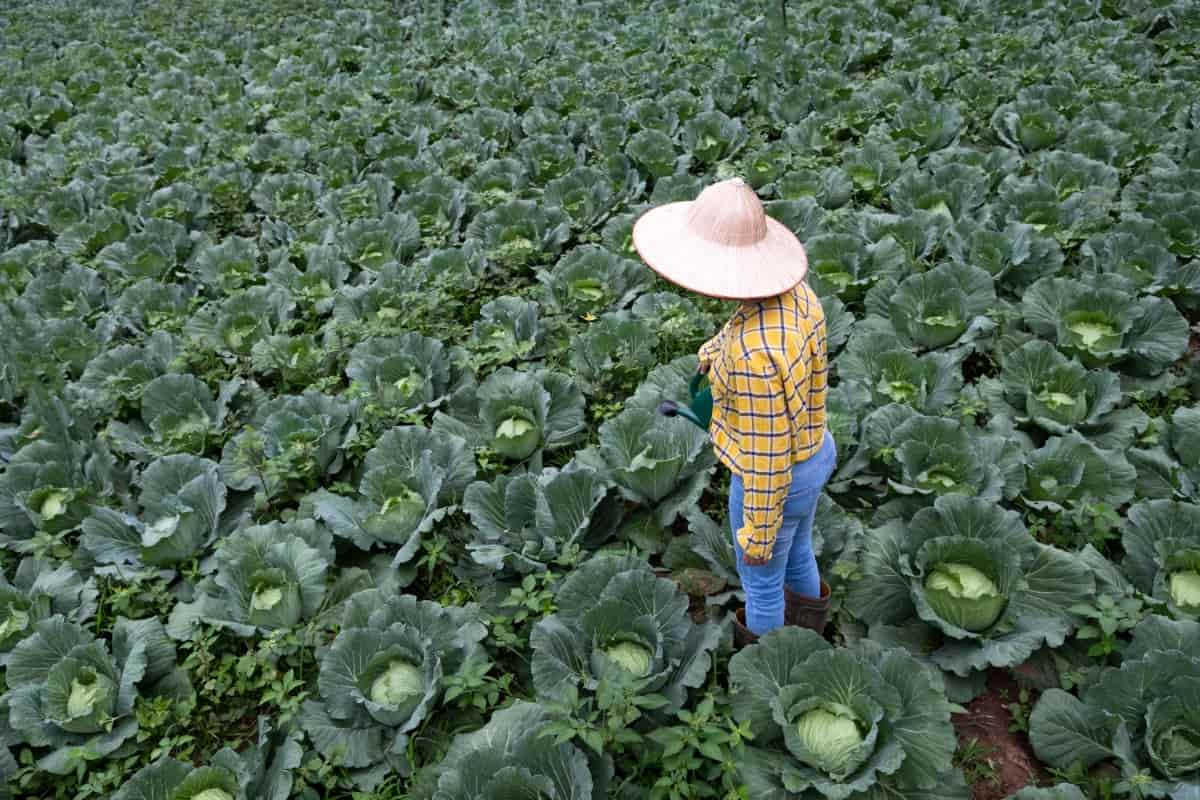When it comes to growing organic Cabbage, choosing the right variety is crucial. Each type of Cabbage has its own unique characteristics and flavor profile, so it’s important to select the one that suits your preferences and growing conditions. One popular variety is the green or white Cabbage. Another option is red Cabbage, which adds vibrant color to salads and slaws. Savoy Cabbage, with its crinkled leaves, has a more delicate texture and slightly sweet flavor.

For those who prefer smaller heads of Cabbage, there are mini varieties available, such as Pixie or Minicole. These compact Cabbages are perfect for individuals or small families who don’t need large quantities. If you’re looking for something different, consider trying Chinese Cabbage varieties like Bok Choy or Napa Cabbage.
Organic Cabbage Cultivation
Soil Preparation for Organic Cabbage Cultivation
Soil preparation is a crucial step in organic Cabbage cultivation, as it sets the foundation for healthy and productive plants. To ensure optimal growth, start by clearing the area of any debris or weeds. Next, loosen the soil, avoid excessive tilling, as it can disrupt beneficial microorganisms in the soil. Spread organic matter over the planting area and mix it into the top few inches of soil.
Testing your soil’s pH level is also important before planting Cabbage. Aim for a slightly acidic pH between 6.0 and 7.5, which is ideal for Cabbage growth. Adjusting pH levels by adding lime to raise acidity or sulfur to lower acidity. In addition to improving nutrient availability, incorporating organic matter helps enhance water retention in sandy soils and improves drainage in heavy clay soils.
Planting Techniques for Organic Cabbage
When it comes to planting organic Cabbage, there are a few key techniques that can help ensure a successful and bountiful harvest. First off, selecting the right time to plant is crucial. Cabbage prefers cool weather, so plant seeds or seedlings in early spring for a summer crop or in late summer for a fall crop. Before planting, make sure your soil is well-prepared.
Loosen it with a garden fork and remove any weeds or debris. Follow up by incorporating organic matter into the soil to improve its fertility and drainage. When it comes to spacing your Cabbage plants, be sure to give them enough room to grow. Typically, Cabbage plants should be spaced about 12-18 inches apart in rows that are 2-3 feet apart.
This allows each plant ample space for proper air circulation and prevents overcrowding. As you transplant your seedlings into the ground, take care not to bury them too deeply. The base of each seedling should be level with the surface of the soil once planted. Gently firm the soil around each plant to provide stability while still allowing roots easy access to water and nutrients.
Organic Fertilization Methods for Cabbage
One of the key aspects of organic Cabbage cultivation is choosing the right fertilization methods. Compost is a fantastic option for organic fertilization. It enriches the soil with organic matter and improves its structure. To make compost, collect kitchen scraps, yard waste, and other materials in a compost bin or pile.
In case you missed it: Cabbage Farming in Vertical Systems: Growing Cabbage in Vertical Spaces

Another effective method is using animal manure as fertilizer. Just ensure that the manure has been properly composted before use. Cover crops like Clover or Legumes are also beneficial for adding nitrogen back into the soil. These green manures can be grown between rows of Cabbages during fallow periods or as an intercrop alongside your main crop.
Irrigation Strategies for Organic Cabbage
Irrigation is a crucial aspect of organic Cabbage cultivation. One effective method is drip irrigation. This system delivers water directly to the roots, minimizing evaporation and reducing weed growth. It also prevents foliage from getting wet, which can reduce the risk of fungal diseases. Another strategy is mulching around the base of the Cabbage plants. Organic materials like straw or grass clippings help retain soil moisture by reducing evaporation. Mulch also suppresses weed growth, conserving water for your Cabbage crop.
Monitoring soil moisture levels is essential in determining when to irrigate. When watering, aim for deep root penetration rather than shallow surface wetting. This encourages strong root development and resilience against drought conditions. Avoid overhead sprinklers whenever possible, as they can promote leaf diseases by keeping foliage consistently moist. Remember that different stages of Cabbage growth have varying water requirements; seedlings need more frequent but lighter watering compared to mature plants.
Organic Pest and Disease Management in Cabbage Cultivation
One method of pest control is biological control. This involves introducing beneficial insects that prey on pests such as aphids or caterpillars into the Cabbage field. By alternating Cabbage with other unrelated crops each season, you can disrupt the life cycle of pests that may be specific to Cabbage plants.
In case you missed it: Cabbage Farming in Greenhouse: Growing Cabbage in a Controlled Environment

In terms of disease management, practicing good sanitation is essential. Removing diseased plant material promptly and disposing of it carefully can prevent the spread of diseases like black rot or clubroot. Another organic approach is using natural remedies such as neem oil or garlic spray. These solutions act as deterrents for pests while being safe for consumption. Regular scouting and monitoring for signs of pests or diseases allow us to take action promptly if any issues arise.
Weed Control in Organic Cabbage Farms
One of the challenges faced by organic Cabbage farmers is controlling weeds without using chemical herbicides. However, there are several effective weed control methods that organic farmers can employ. Mulching is a popular technique used to suppress weed growth in organic Cabbage farms.
By covering the soil around the Cabbage plants with a layer of mulch such as straw or wood chips, weeds are prevented from germinating and getting access to sunlight. Hand weeding is another labor-intensive but effective method for weed control. Regularly inspecting the Cabbage beds and manually removing any unwanted weeds helps keep them under control.
Cultivation tools like hoes or hand forks can also be used to uproot small weeds without damaging the roots of the Cabbage plants. Care should be taken when using these tools to avoid injuring the delicate root systems of young Cabbages. Cover crops can play a crucial role in suppressing weed growth as well. Planting cover crops between rows of Cabbages not only provides competition for weeds but also improves soil health and fertility.
Crop Rotation and Companion Planting with Cabbage
Rotating crops helps maintain soil fertility as different crops have varying nutrient requirements. When planning your crop rotation, it is best to avoid planting Cabbage or other brassicas in the same spot year after year. Instead, rotate them with non-related crops like legumes or root vegetables. Companion planting is another effective technique for organic Cabbage cultivation.
In case you missed it: Top 10 Best Cabbage Varieties to Choose for Your Farm

Certain plants can help repel pests or attract beneficial insects to your Cabbage patch. For example, interplanting Marigolds with Cabbages can deter harmful nematodes while attracting pollinators like bees. Onions and Garlic also make great companions for Cabbages as their strong odors confuse insect pests such as aphids and caterpillars. Additionally, herbs like Dill and Thyme can provide a habitat for predatory insects that feed on common Cabbage pests.
Conclusion
Organic Cabbage cultivation offers numerous benefits for both the environment and our health. By growing Cabbage without chemicals, we can ensure that our food is free from harmful pesticides and synthetic fertilizers. This not only promotes a healthier lifestyle but also contributes to the overall well-being of the planet. Organic Cabbage farming requires careful planning, proper soil preparation, and consistent maintenance. However, with the right techniques and dedication, it is possible to grow high-quality Cabbage organically.
- Feed Your Flock for Less: Top 10 Tips to Save on Chicken Feed
- Ultimate Guide to Ossabaw Island Hog: Breeding, Raising, Diet, and Care
- Hatching Answers: The Top 10 Reasons Your Chickens Aren’t Laying Eggs
- Eggs and Economics: Breaking Down the Cost of Raising Backyard Chickens
- Defend Your Greens: Proven Methods to Keep Iguanas Out of Your Garden
- Ultimate Guide to Cinnamon Queen Chicken: A Comprehensive Guide for Beginners
- Ultimate Guide to California Tan Chicken: Breeding, Raising, Diet, Egg-Production and Care
- Ultimate Guide to Marsh Daisy Chicken: Breeding, Raising, Diet, and Care
- 10 Types of Chicken Farming Businesses You Can Start for Profits